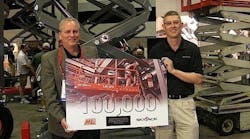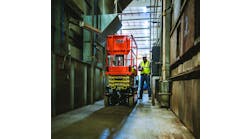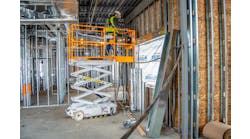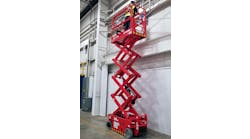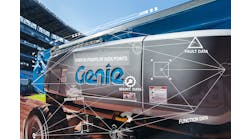Brad Boehler has made his mark on the aerial rental industry since taking over as Skyjack president in 2011. Boehler sat down with RER’s Michael Roth at the recent ConExpo show to talk about his future goals for Skyjack, his thoughts about aerial safety and how he came to the aerial industry.
RER: Please tell us about your background before coming to Skyjack.
Boehler: I graduated from engineering school as a civil engineer, got a degree and went into the Canadian military for a while. I enjoyed my time there, but that wasn’t what I wanted to do for the rest of my life. I did a few other things, then ended up at Tigercat Industries, a forestry company. I did some design work as an engineer there and ended up being what they called the engineering administrator. I was responsible for hiring engineers, for standards and safety and liability and some warranty stuff. I was wearing a lot of different hats there.
Then Linamar bought Skyjack in 2002 and shortly thereafter they saw they had a lot of liability and claims because it’s an inherently dangerous business. So Linamar needed someone to help them with that and I had the right kind of things on my resume so I came to Linamar, Skyjack specifically.
I came in and looked at the equipment, and looked at what our history had been as far as incidents and accidents and our compliance and regulations, and really what it came down to, at the end of the day, can we make a “safer” machine? But you have practicalities. You have to make a machine that’s not only safe, but saleable. I’m an engineer, so as a start, if you said, “We need you to build a scissorlift that could never fall over.” I can do that, but I guarantee you nobody is ever going to buy one, they just couldn’t afford it. So unfortunately you have risks in everything you do every day, and you do your best to mitigate that risk, but you cannot eliminate risk entirely.
So how do you reduce the risks?
What I did see was that most of the incidents we’ve been involved with could have been better mitigated if a. the machine had been properly maintained or b. the operator was properly trained. The operator needs to be properly trained and should be able to identify when a machine is not properly maintained. At the same time we were reviewing our training programs. Then IPAF came across and were trying to get a foothold in America and that seemed to mesh very well with me, to have an opportunity to have an industry third party certify our trainers, and certify the program that we did.
I looked around and said ok we’ve got some people who are trained operators here, what are their qualifications? So it was good to be able to say we’ve now got a third party who can look at these people, what their experience is and can look at what they know and how they know it, and that they are starting to actually teach people how to be operators on the machines. So all of those things rolled together and things evolved from there.
I’d noticed you are very involved with IPAF and safety issues.
As an industry, the way to keep people from being injured is to provide them with safe equipment, which I think we do, and provide them with the proper training to use that equipment, and those are two very important things.
At ConExpo the new electric scissorlift seems to be the biggest attraction at your stand?
Yes. Obviously there are more and more calls for emission-free machines. The engines that are producing emissions are regulated by EPA and other regulatory bodies and in California by CARB to produce fewer and fewer emissions. So there’s the green aspect and also for working indoors, emissions are important as well. It’s the kind of machine that can be first on the site and last to leave. It can handle outdoor rough-terrain applications; you can have power on the site or put a generator on it, you can generate your own electricity and have the fuel itself, whether it does that automatically or manually. And then when the time comes and you’ve got a concrete floor that you don’t want marked up, you’ve got non-marking tires so you can bring it inside. And once you’ve got a shell of a building and you don’t want emissions to pump fumes into it, you’ve got a no-emission machine machine. It really can stay on the jobsite for the entire cycle of the job.
What kind of acceptance are you finding with Tier 4 machines?
We can talk about political will and what’s good for the environment and various other things but at the end of the day, it becomes a very difficult thing economically, especially in the transition phase because I’ve got Rental Company A that has a machine that’s five years old and Rental Company B and we say to them please buy a new machine. And there’s an economic gap in the actual cost of the machine, and the end user doesn’t want to pay a higher rental rate for a Tier 4. But there’s going to come a time where that rate is going to have to be driven back down to the end user and that’s a very difficult thing for a rental company to do, right? So they look back to us because of cost increases of Tier 4 and we look back to the engine suppliers because the engine costs more. So we all look down that chain and it’s going to be paid for by the end user. It’s hard to do that.
What are some of the goals for Skyjack over the next year or so?
Ultimately our goal is to become a billion-dollar company. And we’re well on the way to doing that, we’re tracking on the way to that now and we are going to do that by product development and market development and customer development. For example, we do very well in the North American market. But there are customers out there we don’t have so we can find lots of new customers in North America, Europe, Asia, Australia and South America. We can develop more customers in all of those areas. We’re developing products every day, it’s a slow process, but we’re going to fill our product line to have a full range of boom products. So each new product you introduce to your current customer base can help the company grow and I think you can attract them to your future customer base as well.
And globally there are some markets that we’re not well represented in so we’re looking to see how we can grow in those markets. So you put those three things together and we can get to a billion dollars relatively easily.
So you want to further develop the boom line? You want to grow it bigger?
Yeah. Right now we entered the core of the market with our products, the 40-foot and the 60-foot. The 40s probably were the core of the market; it’s probably shifted into the 60s, and probably now more into the 80s. So we’re working on the 80-foot telescopic boom now. We’ll have an 80-foot articulated on the board after that. We also appreciate there is probably a smaller electric articulating boom in the marketplace we need to be in, and then when you get to that point, I don’t know what the ratio is of the 80s to the overall boom market, obviously you get more rental. But we’re not ready for the 130 or the 180 or 200 feet, or 185 like JLG; we won’t be in that market any time soon.
I think when we round out that product line and we have the 80s and we have the taller booms, then we have to take a look at where do we want to go and how do we want to get there. Anything over 100 feet is a little further away.
You have hybrids on the horizon?
The hybrid that we have is sitting right there [on the ConExpo stand.] It’s got an electrical battery pack and an onboard generator if you need it. We had a couple of customers ask and a couple of people in the media ask that. There might be other machines we can apply that to and certainly, if we look at a very small, articulated electric boom, I would envision that boom would have the same battery pack.
Would part of your growth plan be furthering your international development?
Yes absolutely. We’ve got sales office in the U.K. and Germany and France and Sweden and in China and Australia, and we’re very close to opening something in Korea shortly, so we kind of look at each individual market or region and determine where we could be next. Korea is a place that may have more used Skyjacks than anywhere other than the United States. There’s a phenomenal amount of equipment that has gone through its first life in this market and has now found a second or third life in the Korean market. So we’d like to try to get some new equipment into that marketplace because our brand has a good reputation there and so we’d like to see how new equipment would do, and we’d like to continue to sell used equipment into that marketplace and perhaps get more after-market parts sold there as well. So all of those translate into us being more active in the Korean market.
How do you see the rental market over the next few years? Do you expect to see more penetration and demand?
I think so. We’ve had growth over the past few years, mostly in the German and North American marketplaces. Some of the key indicators, housing, and commercial, those kinds of things, are expected to grow more rapidly over the next three years from what I hear and those tend to drive rental. So even without those drivers, rental is growing, so it looks like the next few years it should continue to grow.
You mainly manufacture in Guelph? Where else?
We also have a reconditioning facility in Glendale, Ariz., we do some of our service parts there, mostly obsolete parts that aren’t in current production, and we also do reconditioning and refurbishing of machinery there.
You do complete remanufacturing?
If you look at the ANSI standards, there’s a difference in term between remanufacturing and reconditioning and refurbishing, so we do reconditioning in Arizona.
Any new developments in the product support area?
Our new app, the application we are introducing, that gives our customers an easier pathway to getting information from Skyjack. So that is new on the product sales side, for our customers to sell to their customers. And that application offers more information on their point of sale to be able to make that sale. So we are working on online service training as well, that’s under development.
Operator training also?
IPAF has recently introduced an online training program and we are starting to use that as well, so we are offering the AWPT operator training.
